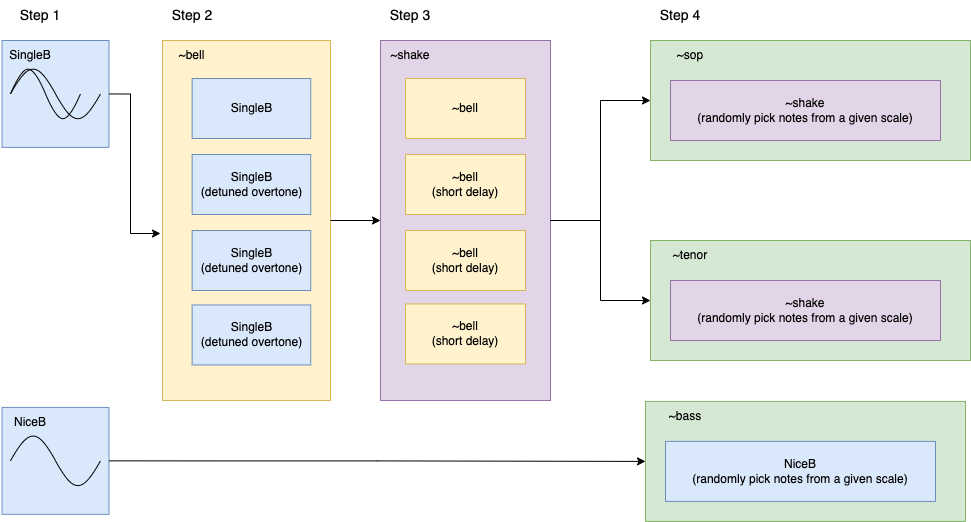An electronic ensemble concert presents uniquely electronic music performed by many musicians. Like all live music events, performers and audiences get experiences they can not get from recorded or streamed media in an electronic ensemble show. It takes work to organize such an event, but there are common routines. I have been directing the Electronic Music Ensemble of Wayne State (EMEWS) since 2017 and have presented more than 30 concerts with them. I share guidelines for planning, executing, and continuing electronic music ensemble concerts in this article. I also share a budget for starting an electronic ensemble.
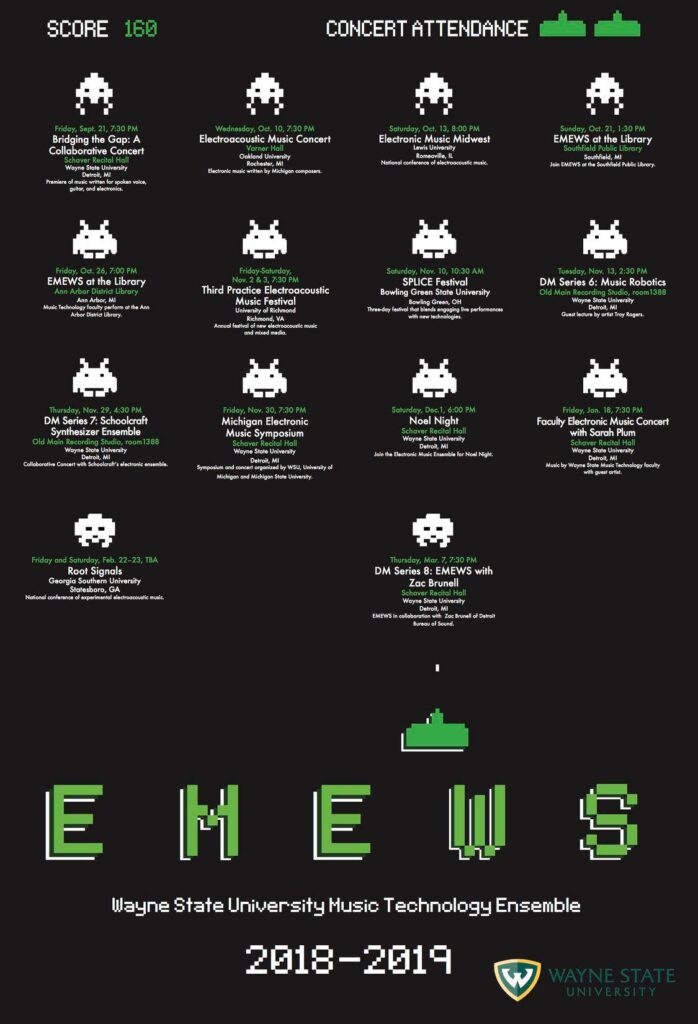
My previous blog post, How to Play a Solo Set, outlines the four steps of planning and presenting a solo electronic music performance.
- Decide pieces
- Decide the order
- Practice transitions
- Practice sound check
Doing an electronic ensemble concert has similar but different steps.
- Learn the Context
- Decide pieces
- Rehearse
- Decide program order and technology
Preparing for an electronic ensemble concert requires more discipline than preparing for a solo performance because it involves more people, rehearsal time, and equipment. The director needs to make some decisions weeks, if not months, before the show. The first step in making the best decisions is learning the ensemble’s social context.
Learn the Context
Unlike an orchestra or choir, an electronic ensemble does not have a set instrumentation or time-tested management protocols. The group can take many forms depending on the institutional structure, vision, and budget. The director should learn the pros and cons of the ensemble’s social context for effective and practical programming. I share the case of EMEWS for reference.
Institutional Structure
EMEWS is a semester-long class in a university with 12 registered students. This means that
- I, as the director and teacher, use the facility and equipment provided by the music department.
- As a credited course, I expect new and returning performers every semester.
- The concert venue is already set. I will have the opportunity to program at least one concert per semester at a venue I am familiar with.
- The semester concert should have a different repertoire than the one in the previous semester.
Vision
My job is to set the direction of the musical style, convince the performers to get immersed in it, and present it to the audience. This means there is a stylistic preference over another for the season. For example, EMEWS has the capacity to play a standard orchestra repertoire using General MIDI, but I do not prefer that. I encourage EMEWS to play music that values the following:
- Experiment: Try a new repertoire that cannot be presented on other instruments. EMEWS plays unconventional and challenging music that may fail—and that is OK, as many experiments tend to fail.
- Liveness: Music technology is more than a recording technology. EMEWS performers learn the here-and-nowness of live performances by playing electronic instruments together.
- Education: Performers should learn new techniques, get opportunities to refine what they know already, and safely share the sound with their peers in EMEWS. Jamming along to the tunes they already know will hardly achieve the stated goal.
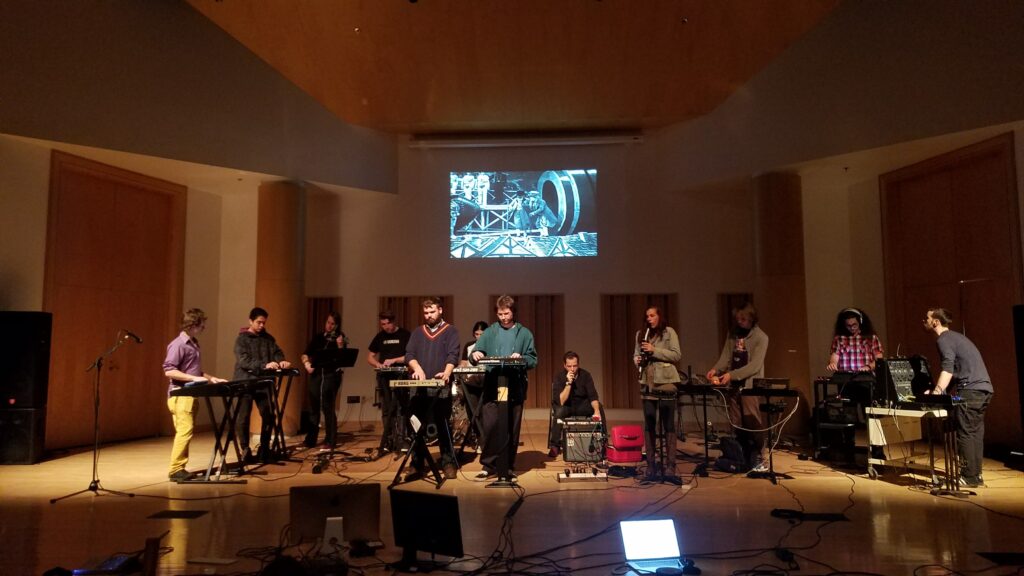
Budget
The director should know the practical limits, such as performers’ skills and the repertoire’s technological feasibility. With EMEWS, I choose or create pieces that require a minimum number of gears. The extra budget I may get from grants is then used for off-campus concerts and gear purchases.
In sum, my suggestions for running an electronic ensemble are based on my experience in a university course. Not all electronic ensembles are in the same situation. The director should assess the ensemble’s institutional relationships, musical vision, and budget accordingly before working on a concert.
Decide Pieces
The most challenging aspect of operating an electronic ensemble is building the repertoire. There is no Beethoven’s Fifth equivalent of an electronic ensemble work, yet. Any pieces presented at the concert will likely be new to the audience. It is a relatively uncharted field for composers to write new pieces.
I aim to premiere one composition at every semiannual EMEWS concert. The rest of the repertoire comes from pieces written by other composers or group improvisations. Some of those pieces are arrangements of existing acoustic compositions.
A typical EMEWS concert lasts one hour and features three to five pieces. However, the total duration may be shortened or extended at off-campus performances. For example, if invited to a music conference, EMEWS may play one piece, or they may perform a 1.5-hour show as a featured artist in a venue.
Rehearse
Electronic musicians may have less experience in ensemble performance, as many of them start their careers as solo DAW artists. It is important to teach the members that they must practice playing as a group by attending every rehearsal. Even the time spent on non-music-making routines in a rehearsal requires training and refinement.
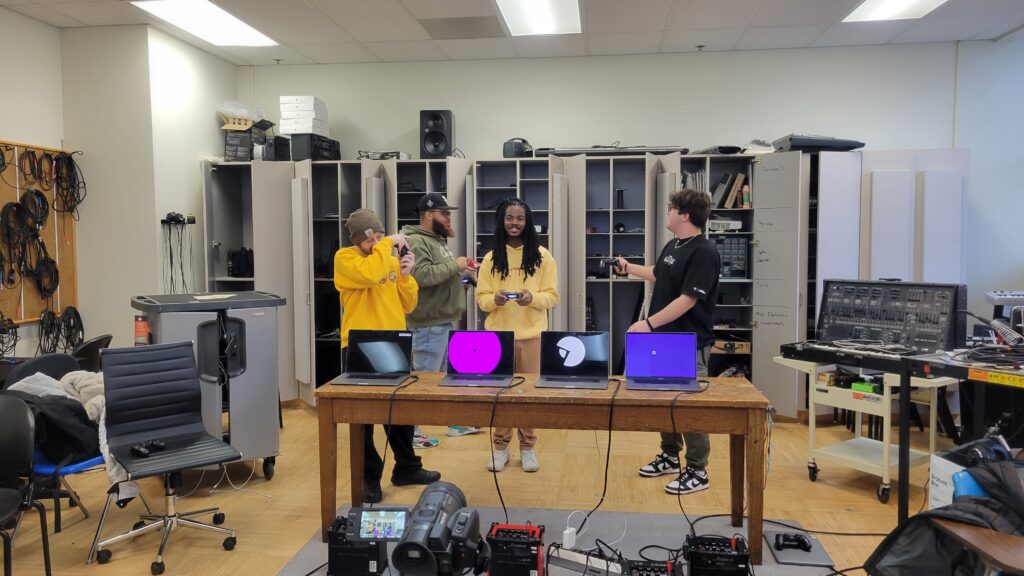
I allocate about seven rehearsals, each lasting 2.5 hours, for a concert. In the first weeks of the semester, the ensemble spends about 30 minutes setting up at the beginning and about 10 minutes clearing up at the end. Each member learns how to set up a computer, an amp (EMEWS has one amp per performer), and a MIDI controller (the rehearsal room hosts multiple keyboards and synthesizers). By the mid-semester, it takes about 10 minutes to set up and 5 minutes to strike. The last week of the semester is Spring Cleaning Day: all members tidy up the rehearsal room by untangling the cables, putting back the keyboard stands, throwing away the broken cables, etc. One of the goals in rehearsal should be improving the technical and technological sides of an electronic music performance.
Decide Program Order and Technology
The program order is finalized about a month before the concert. EMEWS presents a Fall or Spring concert during the 8th or 9th week of the semester and usually decides which pieces to include in the concert during the 5th week. The concert program needs to be practical—it must use already available gear, and the time for set changes between the pieces should be as short as possible. For that purpose, a list of questions on necessary technology helps me work on the logistics.
Laptop ensemble or mixed-instrument?
Laptop-only electronic ensemble pieces are easier to set up than those involving synthesizers and acoustic instruments. Program the most technologically complicated pieces (ones with many instruments, cables, speakers, and furniture) early in the program. Strike the gear as much as possible between the rest of the pieces for better visuals and performer mobility.
Amplified or unamplified?
More instruments to connect to a PA or house mixer means more power strips, audio cables, and set-up time. Make sure to do a final rehearsal with all the gear present at the same time. If there are enough performers, laptop-only compositions may not require additional amplification. Not being connected to an amp on the stage also allows the performers to move freely. An outdoor performance is also possible without extra set-up.
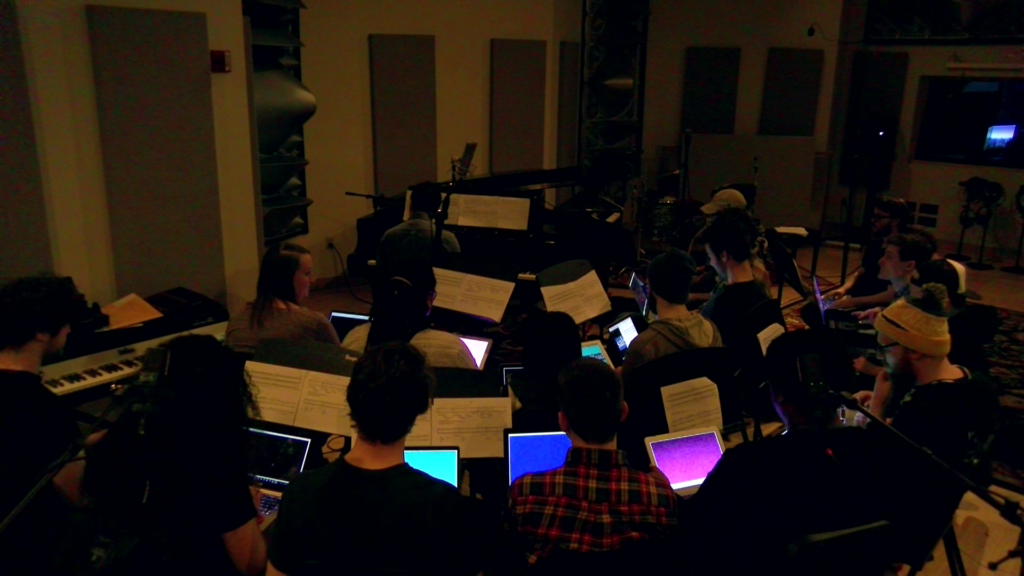
Video projection or no video?
A repertoire using a video projection needs attention in programming order. Extra set-up time or a stage crew may be needed to test and run the video pieces. If the projector’s fan noise is loud, it should be turned on right before the piece and turned off right after.
On tour or on campus?
An ensemble can go all-out in terms of gear for an on-campus show. As long as the performers do not mind the additional setup and strike time, they can use all the gear available. However, it is challenging to carry around big gear on tour. It is wise to minimize the risk and random factors in terms of gear when performing in an unknown venue.
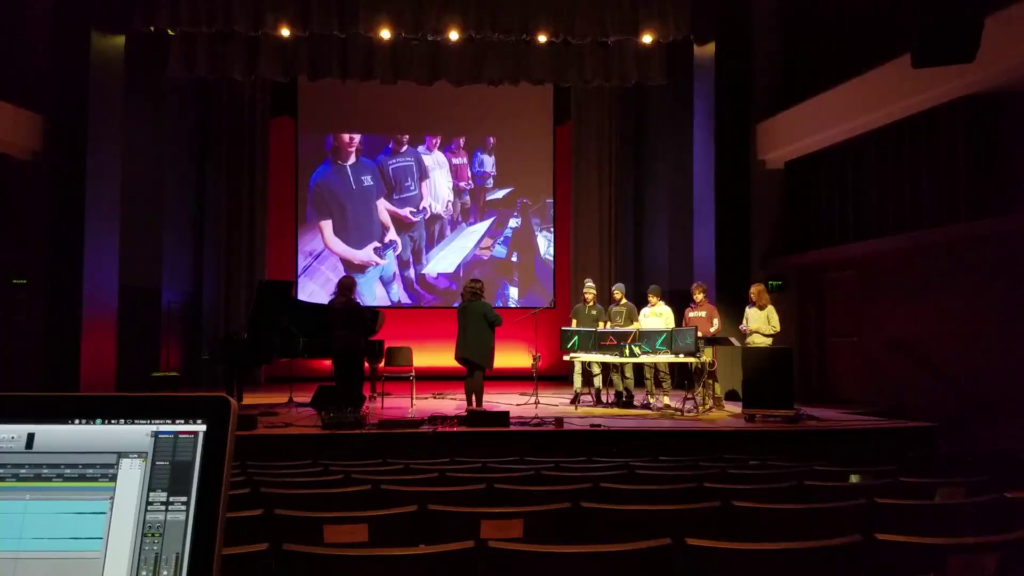
Startup Budget Consideration
If a reader is interested in starting an electronic ensemble, the first question would be how much it costs to start a group. I recommend checking the availability of the following starter pack.
- Laptop: One laptop per performer, either PC or Mac, is recommended. Do not worry about what DAW or plugins to purchase; there are free apps and free-to-run laptop ensemble repertoires. If a performer already has a laptop, they could use it as an ensemble instrument. There is no need to use a top-of-the-line computer. I use a $350 PC laptop.
- Rehearsal space: The ensemble should secure a room where they can meet regularly. A laptop purchase may be delayed if the ensemble can secure a computer lab. Be aware that there will be loud noises.
- Amps and cables: I prefer a cheap, portable amp per performer over one loud PA. A direct audio connection ($7 for 6ft) from the computer’s audio out to the amp’s input bypasses the need for audio interfaces. A mono output to an amp or selecting a channel from a stereo output is fine, in my opinion. EMEWS uses a dozen Roland Micro Cubes (used to be $150) that run on AA batteries. The ensemble sometimes uses a guitar strap on the amp to carry the amp during the performance.
- After the laptop, rehearsal space, and amps, buy the gear necessary for the specific repertoire. For the most versatile use, I recommend getting a small, cheap MIDI controller ($100).
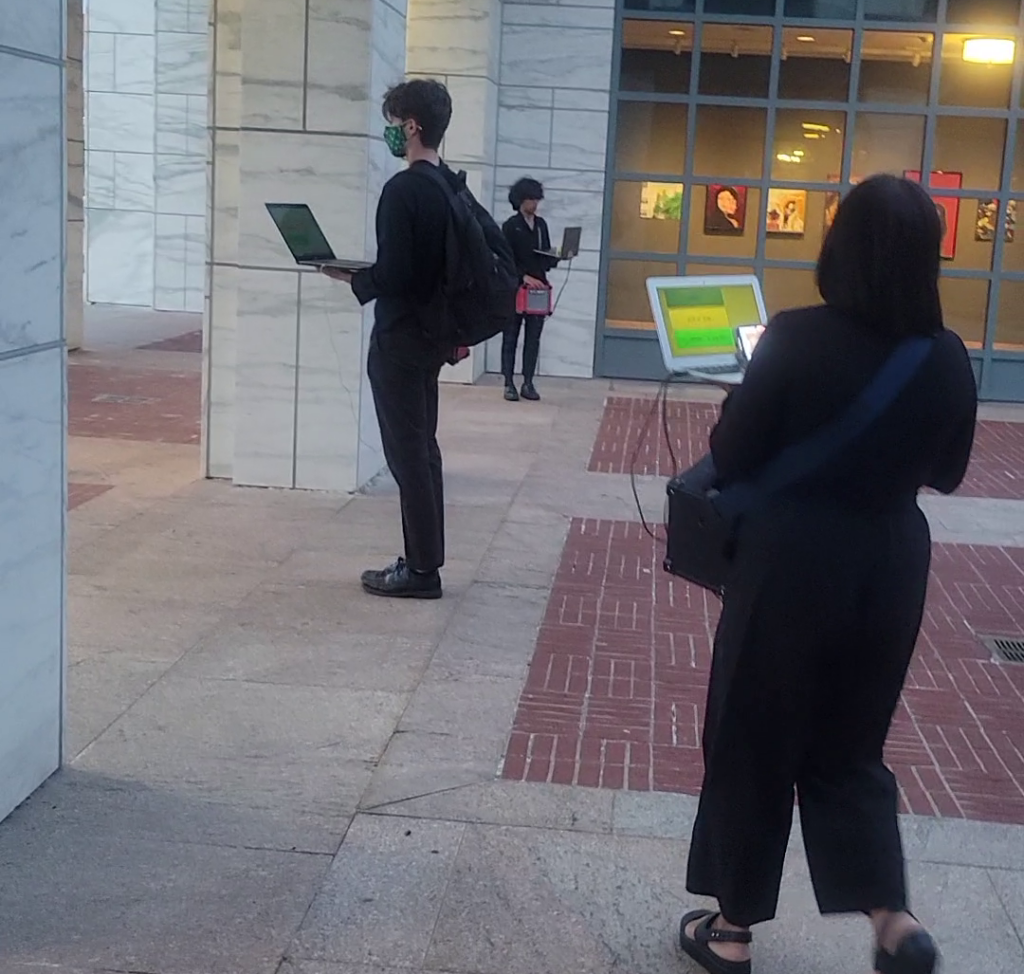
The above list also shows the purchasing order. If the budget is tight, secure the laptops first. Once the laptop and rehearsal space are available, the ensemble can begin to play. If the budget is bigger, get the amplification system and cables. Leave some money for perishables, such as batteries and extra cables. They will probably be on demand ten minutes before showtime!

